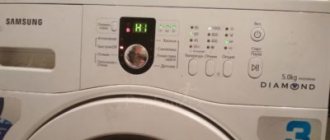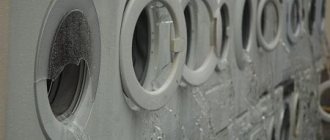A dishwasher (hereinafter also referred to as PMM, dishwasher) immediately after purchase probably pleased its owners with clean, shiny plates, cups, glasses and cutlery. But over time, it became clear that the dishwasher did not wash dishes well, and the reasons for the deterioration in performance were unknown. What's really going on with the dishwasher and how to fix the situation? From the article you will learn the reasons for this behavior of your faithful assistant and get acquainted with recommendations on how to eliminate them.
The quality of washing dishes in the dishwasher gradually deteriorates, and the housewife is not always able to immediately notice that the glasses, cups and plates are not completely washed
Why does a dishwasher wash dishes poorly?
Visual signs of improper operation of washing equipment from Bosch, Siemens and other well-known manufacturers include food residues on the surface of plates, dirty deposits or white stains.
There may be several reasons for poor cleaning of tableware:
- negligent attitude towards timely preventive cleaning of PMM parts;
- improper operation of the dishwasher - owners do not read the instructions;
- ignoring the requirement to use only special detergents intended for dishwashers.
The quality of washing can be assessed by the cleanliness of the white surface of the plates
In most cases, the quality of cleaning dishes deteriorates gradually and is almost unnoticeable right away. As a result, there comes a time when the PMM stops doing its job properly.
If your dishwasher doesn't wash dishes well, what should you do? Below we will consider in detail how to get rid of such a malfunction.
Possible problems: how to fix?
Let's consider possible malfunctions in which the PMM may not cope 100% with its main function:
Heating element failure
Every PMM is equipped with a device that heats water to the required temperature. Thermoelectric heater (TEH) is most prone to scale accumulation on its surface. The longer a coated heating element operates, the sooner it will burn out. After the heater fails, the machine ceases to cope with its main function - and the quality of washing drops to a minimum, since it is difficult to wash something in cold water. In this situation, it is necessary to disassemble the machine body and completely replace the heater with a new part.
Circulation pump failure
The pump that pumps water inside the dishwasher, if it fails, blocks the supply of water for the washing process, hence the dirty, cloudy dishes. The way out of the situation is to replace the part with a new original.
Sprinkler impeller problems
The impeller is a mechanism that rotates a rocker arm with sprinklers. If it fails, rotation stops (either one impeller or two) and the dishes are not washed well. The way out is to replace the impeller.
Temperature sensor failure
The temperature sensor (thermal relay) is used to measure the water temperature. The information received by the sensor is fed to the electronic module, which commands the heater to begin heating. If the data is incorrect (or not supplied at all), the heating element does not start and washing occurs in cold water - hence its low quality. The sensor needs to be replaced with a new one.
Malfunction of the control module
The task of the software board is to send commands to all PMM nodes. So, the module controls heating, draining and other processes. If it breaks down, the board does not work correctly, causing the machine to malfunction. In this case, the module must be flashed or replaced with a new one.
Delayed cleaning of dishwasher parts
Perhaps this is the main reason for the poor performance of the PMM. If you do not monitor the technical condition of the unit, over time it will stop functioning.
The following parts require regular inspection and cleaning of dirt, scale, deposits and food debris:
- filter element inside the dishwasher;
- mesh inlet filter for coarse purification of tap water;
- rocker spray nozzles;
- the walls of the chamber in which all utensils are washed.
The parts that require weekly cleaning are the filter and mesh, located in the bottom of the chamber, next to the sprayer. These filter elements allow you to use water at least twice (in order to save it), which cleans it from food residues, dirt and debris.
Dishwasher filter and its location in the bottom of the chamber
The filler mesh filter does not need to be cleaned as often as the main filter element. It is necessary to check and wash off rust and small particles that flake off the rusty surfaces of pipes from the mesh at least once a month.
Removing, checking and cleaning the fill filter from debris and rust
Particular attention should be paid to the sprinkler nozzles. They periodically become clogged with scale, and less often with small food debris. There are two ways to clean nozzles:
- mechanical - using a regular toothpick;
- preventative – using a special cleaning agent.
Preventative cleaning of injectors is done at least once every six months. To do this, start the wash with a low temperature liquid, without tableware. The cleaning agent - Finish, UniPlus or another - is placed in the chamber or poured into the detergent or rinse aid hopper (depending on the method of application suggested by the manufacturer).
Cleaning the spray nozzles with a toothpick
The recommended cleaning frequency is indicated in each manufacturer's instructions. In addition to cleaning the injectors, dirt and scale deposits are removed from the tubular electric heater (hereinafter also referred to as heating elements), as well as grease from the chamber walls.
In addition, inspection and mechanical cleaning of the chamber walls and the base of the door are recommended - food residues and dirt may be deposited in these places. Problem surfaces should be wiped regularly with a dry cloth.
We recommend reading our article on cleaning your dishwasher yourself.
Heating element malfunction
Older dishwasher models did not have thermistors that control the temperature of the water in the chamber. Therefore, if the heating element malfunctions, the equipment does not display an error code, and the cycle is performed without heating. Grease and stubborn stains will definitely not be washed off at low temperatures, so check the heater.
Most PMMs are equipped with flow-through elements, and replacing them is not difficult. The part is in conjunction with the drain pump. You will have to remove the bottom, unfasten the wiring, and unscrew the pump. Then remove the pipes from the heating element mounts and pull it out of the housing. For replacement, select only the original part.
We have looked at the main reasons why the machine does not start washing dishes. Follow the operating rules, clean the PMM hopper from blockages. The video shows recommendations for cleaning PMM at home:
Source
Consequences of improper use
One common mistake is loading cutlery items incorrectly into the sink baskets. A careless attitude to the rules for arranging dishes can play a cruel joke on the owner.
If you place the cups haphazardly, bottom down, the dishwasher will not wash them well
The instructions included with each PMM model describe the rules for laying out cutlery, which must be strictly followed - only in this case the manufacturer guarantees the high-quality operation of the dishwasher.
There are several rules that are required to fill out all PMMs:
- plates, cups and pots must be positioned in such a way that liquid can drain from them;
- There should be gaps between tableware so that water can freely pass through them in both directions;
- cutlery located in the lower basket should not prevent liquid from flowing from the lower sprayer onto the dishes in the upper basket;
- Tableware should be placed in such a way that it does not interfere with the rotation of the spray arms.
Do not overload the dishwasher as this will make it difficult for detergent to reach the surfaces of cutlery. As a result, the dishes will not be washed well .
We invite readers to watch a video showing how to properly place utensils in the dishwasher:
We invite you to read our article on how to properly load dishes into the dishwasher.
The wrong choice of the PMM operating program is another user mistake. This is mainly due to the discrepancy between the temperature of the liquid and the value that is necessary to remove dried food debris. The dishwasher will stop washing dishes well, removing dried dirt from the surface of the plates, if you run the quick wash mode. In this mode, the water temperature does not exceed +50 ℃, and this is not enough for high-quality cleaning of cutlery.
If immediately after eating you free the dishes from food residues so that they do not dry out on the surface, then the cutlery can be washed quickly and the filter will become clogged much less.
Video
We suggest watching a video about what to do if the PMM does not wash kitchen utensils well:
Electronic engineer with many years of experience. For several years he was involved in organizing the repair of household appliances, including washing machines. Loves sport fishing, water tourism and travel.
Found a mistake? Select it and click the buttons:
Washing machines have something to do with the origin of the expression “money laundering.” In the 1930s, American gangsters used a network of laundries as a cover for their illegal activities. By passing off the proceeds of crime as proceeds from cleaning clothes, they turned “dirty” money into “clean” money.
Problems with detergents
The choice of low-quality detergent and incorrect dosage of household chemicals are also factors that lead to a deterioration in the quality of PMM operation. For example, this phenomenon is observed in cases where the detergent is replaced with a cheaper product or low-quality tablets.
White streaks on the surface of glass or porcelain indicate insufficient rinse aid in the water
Insufficient amounts of rinse aid and detergent lead to poor cleaning quality of kitchen utensils. Therefore, household chemicals should be dosed strictly according to the instructions included with the dishwasher.
If you regularly and promptly care for your household appliances, they will work without breakdowns or failures.
So, for the dishwasher to work properly, you need to follow a few simple rules. Once you start following them, your dishwasher will clean dishes well.
Option 3. Incorrectly selected mode
If you use special tablets and other solvents for washing, then pay attention to the mode in which the washing takes place. Each tablet has such a concept as dissolution time and temperature.
So, if you use an express wash with water heating less than 50 g. the tablet simply may not have time to dissolve. As a result, the dishes were not washed, and the money for the product was wasted.
Therefore, read the instructions for use of the product and choose the mode that will allow you to use this product with maximum efficiency.
Option 7. The filter is clogged
Many housewives overlook such an important procedure as cleaning the dishwasher filter. But in vain. The filter takes care of all the unpleasant things that happen during washing - it removes food particles and large contaminants.
And, of course, it gets clogged quickly. Therefore, in order for dishwashing to be as efficient as possible, it is recommended to clean the filter as often as possible. Someone says that you need to do this after every wash. This is ideal, but not required. Do this at least every 3-4 washes, and only if a lot of dirty dishes were loaded.
The filter will also not clog quickly if you thoroughly clean it of large food residues before loading dishes.
Source











